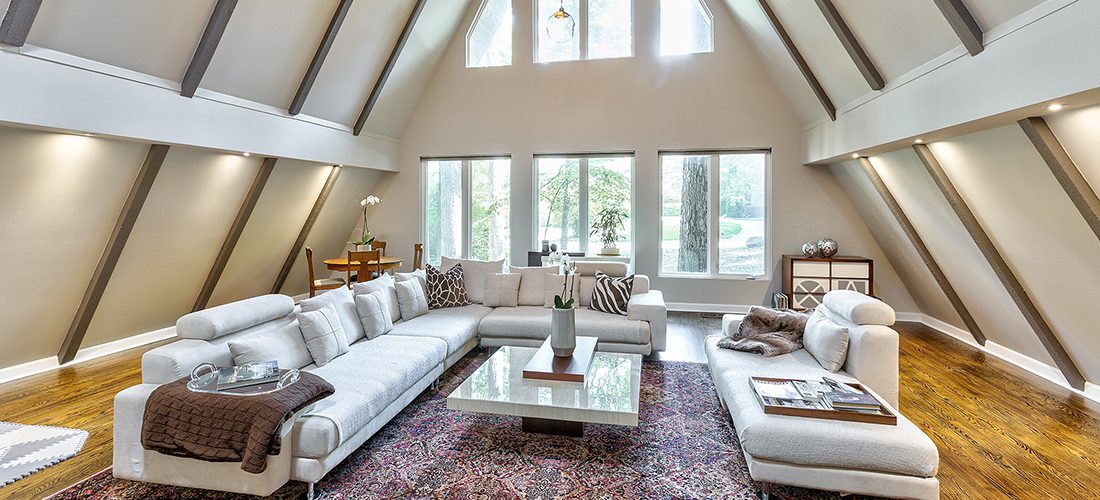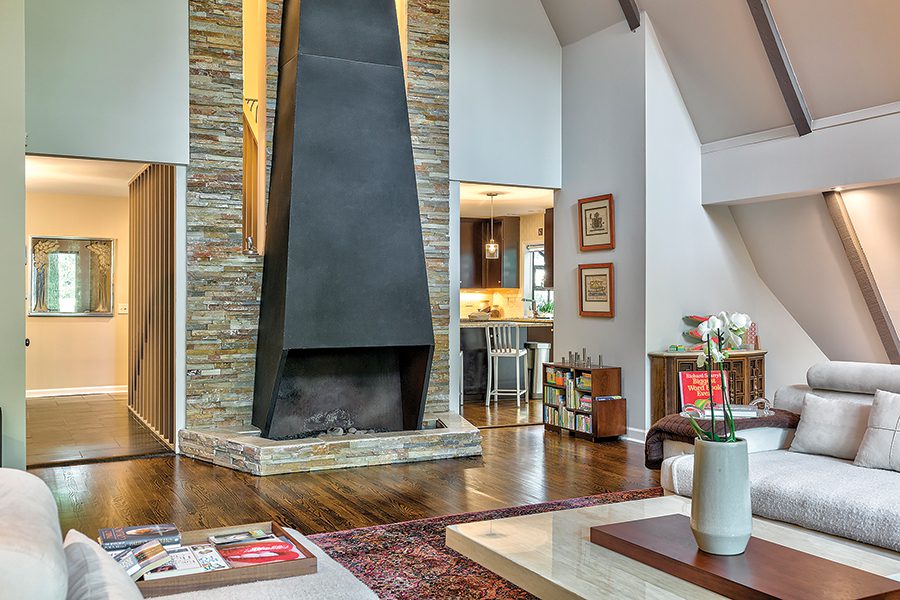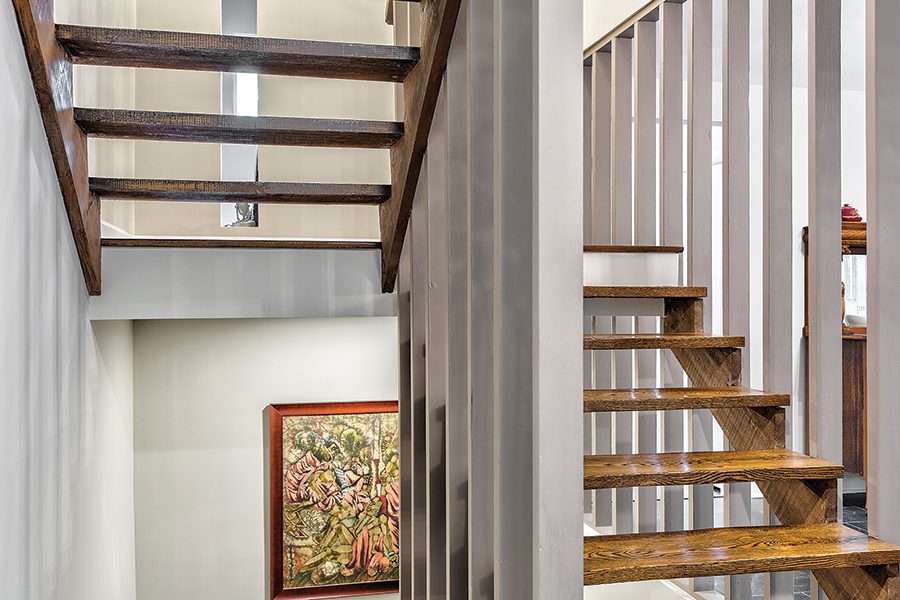All angles
September 1, 2021

A 1964 A-frame is one of five midcentury marvels featured on this year’s virtual Mad About Modern home tour.
by Cathy Martin | photographs by Digital Lasagna
When someone mentions classic A-frame architecture, quaint vacation homes come to mind — a laid-back surf shack by the beach, or a snug mountain getaway. The architectural style peaked in popularity from the 1950s through the 1970s — you could even order a prefab kit and build your own.
During that time, Frank and Bonnie Mullen were living in Dayton, Ohio, when Frank, a psychologist and researcher, decided to join the faculty at Queens College (now Queens University). Ahead of their move to the Queen City, the couple subscribed to The Charlotte Observer, where they read an article about a German architect building A-frame churches in North Carolina. They commissioned the architect to build a home for them on a wooded lot in their new city.

“It was very peaceful and quiet living at the end of the cul-de-sac in the middle of a woods” recalls Bonnie Mullen, now in her 80s and living in Florida. The Mullens only lived in the home for five years before Frank took another university job in Michigan, but the flat-topped A-frame built in the shape of a cross still stands. It’s one of five mid-mod houses on this year’s Mad About Modern home tour, now in its 10th year. Like last year, the tour organized by The Charlotte Museum of History will be virtual, with a VIP kickoff event at the museum on Sept. 23.
Perched on a sloping lot that backs up to Little Sugar Creek, the A-frame completed in 1964 is a relic, surrounded today by large, modern homes. Like many neighborhoods in the area, several of the original houses on the street have been torn down and replaced with infill projects.
When Jennifer Misenheimer first visited the 2,700-square-foot house a decade ago, the home had seen better days. A rental property for years, floors were covered in green, thick-pile carpet, and much of the home’s original charm had been lost, thanks to a hodgepodge of renovations.
“It wasn’t cool vintage — it was like that vintage that went out of style for a reason,”says Misenheimer, an artist and hairstylist who discovered the house when a friend was renting it. “It had a very hunting-lodge vibe.”
Still, the home made an impression.

“I remember the first time I walked into [the living room], I just got this feeling like, it’s really one of a kind. I have never been anywhere else exactly like this. We had a fire going in the fireplace, and another friend of ours was playing some records.” A few years later, after her friend announced he was moving, she discovered the owners were ready to sell.
Misenheimer, who was 29 and living in a condo at the time, watched and waited as the price dropped, then dropped again. It was 2012, and the country was still climbing out of the Great Recession. After a while, the sellers turned off the power and listed the property as a lot. “And that’s when I got really nervous that it was going to get torn down,” Misenheimer says. After consulting with her Realtor and her father, she made an offer and eventually purchased the home.
Misenheimer’s original plan to replace the carpet and kitchen countertops mushroomed into a full-home renovation that included everything except the kitchen cabinets and an upstairs bathroom, which she recently updated.
“Unfortunately, when you start renovating, when you fix something ugly, something that wasn’t that ugly before suddenly looks really outdated,” says Misenheimer, who lives in the home with her toddler son. Luckily, underneath all that hideous green carpet were white oak floors, which Misenheimer had refinished in a medium tone to bring out the natural wood grain. New, larger windows were installed in the living room to let in more natural light. Stacked stone was installed to cover the painted cinder-block wall behind the black metal fireplace, which was designed by the original architect. Skinny columns that limited the amount of usable floor space were removed and replaced with load-bearing beams to open up the space, and track lighting was replaced with softer undermount lights.
In the stairwell, Misenheimer kept the original open beams that allow light to filter through. Features such as built-in desks in the kitchen and in an upstairs bedroom were also left intact, though Misenheimer did make a few structural changes, adding a powder room and reconfiguring the owner’s suite.

Piecing together the history of the home and its various owners through the years has been a fun part of the renovation process, Misenheimer says. In a closet under the stairs leading to a screened loggia beneath the house, Misenheimer found hundreds of terra cotta pipes that had been used for storing wine. When she mentioned the discovery to a friend and wine collector, he recalled purchasing a few bottles from the home’s previous owner. After removing the pipes, tearing out the wallboard and installing new flooring, she now uses the area for wine storage as well.
Renovating around the unusual angles of the home has been a challenge, Misenheimer says, but worth the effort to maintain the integrity of the original structure.

“It’s funny, I didn’t see myself setting out to be a preservationist. I just had a goal — I wanted a house when I was 30, and with the housing market the way it was at the time, it was a really good time [to buy],” says Misenheimer, who grew up in a midcentury home off Sardis Lane.
“Growing up in one of these homes is why I’ve always loved 1960s houses, and I didn’t want something cookie-cutter,” she says. “There are just so many beautiful things here that we’re not preserving — I was really happy to be able to make sure that this didn’t end up as a new build.” SP
Mad About Modern: Learn more about this home and other notable mid-mods on this year’s Mad About Modern home tour. The virtual event includes 360-degree tours of five historic, midcentury homes in Charlotte, plus a digital guidebook. Purchase tickets and learn more at madaboutmodern.com, including details about a VIP kickoff event at The Charlotte Museum of History on Sept. 23. All tour proceeds support the museum’s mission of saving and sharing Charlotte’s history.